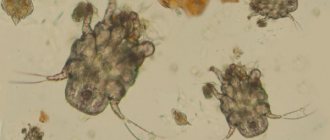What will you learn from the article?
- The causative agent of demodicosis in cats is the subcutaneous mite. Routes of infection
- Risk group
- Diagnostics
- Treatment of localized form
Demodectic mange in cats is a parasitic disease that affects the skin and hair of animals. The cause of this disease is the subcutaneous demodex mite. In our article we will tell you which ectoparasites cause pathology, what are the first symptoms of infection, what forms of the disease exist, and how it is treated.
Varieties
The parasite that infects the skin of an animal is called demodex, and it cannot even be called a mite in the full sense of the word.
It would be more correct to say that this is a microscopic organism, resembling a worm in appearance, but it is impossible to see it with the naked eye, only with the help of a microscope. And if you look at a photo of a subcutaneous mite in cats, you can see how disgusting a parasite it is. There are two types of demodicosis: localized and generalized.
In the first case, only one area of the body is affected (for example, ears, eyes, neck, etc.), while the second type of disease is more severe - several areas of the body are already affected. If a cat has suffered a generalized form of the disease, then it should be sterilized to avoid inheritance of demodicosis. In any case, at the slightest sign of a subcutaneous tick, it is recommended to immediately show your pet to a veterinarian.
Types of lesions
There are two types of cat infestation with subcutaneous mites:
- localized form;
- generalized form.
If the first type of lesion appears only in a limited area or in several areas on the body, leaving the animal’s paws completely healthy, then almost the entire cat’s body suffers from the second type. In case of a generalized form of the disease, experts advise sterilization (castration), since there is a high probability of transmitting the subcutaneous mite to a future generation.
What does a subcutaneous mite look like in cats?
There are 2 types of ticks in cats:
- Demodex cati.
Demodex cati is a permanent inhabitant of the cat’s body and is generally a peaceful resident. The variety can be transmitted from mother to kittens in the first days after birth. Not contagious to other animals. The body is narrow, elongated in length, approximately 0.5 mm. Habitat: hair follicles. This is the most favorable place for the parasite: there is food in the form of lymph, blood, dead cells, and optimal temperature.
D.cati is a cat's friend, as it eats dead skin cells and sebaceous secretions. But he becomes an enemy when his food turns out to be of “poor quality” due to the animal’s health problems.
A tick attack by D. cati begins when the pet’s immunity is weakened, under poor living conditions, or when taking drugs to artificially suppress the immune system. Therefore, demodicosis cati is almost always accompanied by chronic viral infections: peritonitis, immunodeficiency, leukemia. The tick in a cat can become more active against the background of diabetes mellitus and lupus erythematosus.
- Demodex gatoi.
Demodex gatoi are highly contagious. They live in the stratum corneum of the skin and do not affect the hair follicle. The body is short and wide. Infection occurs through contact with a sick animal. But a person can also bring a dangerous “fragment” of fur with parasites into the house. This is how completely domestic pets that do not walk on the street become infected. It is noted that the activation of this type of parasite is not associated with weakened immunity.
Drugs
All medications for subcutaneous mites in cats are selected exclusively by a doctor. The list of funds below is for reference only.
| Category | Drug name | additional information |
| Preparations for injections | Infermectin Otodectin Ivermec Novomec | Dosage – 1 ml per 10 kg of weight. The injection is given once a week. Minimum course – 2 weeks. It is administered subcutaneously or intramuscularly. The first method is considered more effective. Control is carried out by scrapings. |
| Dectomax Meradoc | 0.5 ml per medium-sized cat. Repeated injection after 10 days. Lasts for a long time. Has no side effects. | |
| Aversect | 0.1 ml every 5-7 days until recovery. Inserted into the withers or knee fold. | |
| Drugs that increase the resistance of immunity to parasites (immunomodulators) | Immunoparasite Maksidin Gala-vet Gamavit Ribotan | Immunoparasitan is the only drug of its kind that increases the body's resistance specifically against demodex. |
| Acaricidal ointments/gels | Ivermek-gel Amidel gel Neo Aversectin ointment | Treat the affected areas and adjacent areas to a depth of 2 cm. |
| Solutions | Neostomazan Butox Mycodemocid Amit forte Tsipam | The medicine is diluted with water. Use strictly according to instructions. |
| Sprays | Acaromectin Ivermec | |
| Drops on the withers | Stronghold Lawyer | Course – 2-4 months |
| Shampoos | Doctor Elite | Needed to clean the skin of a sick animal. |
| Anti-inflammatory drugs (external) | Ointment Pikhtoin Sea buckthorn oil Saphroderm gel | Used to soften and remove crusts. You cannot peel off the crusts yourself. Demodex begins to multiply with a vengeance, since the secreted sputum (ichor) is its main food. |
| Hepaprotectors | Essentiale Hepatovet Heptral | Any injections with an acaricidal focus place a large load on the liver. Therefore, hepaprotectors are necessary in complex therapy. |
| Nutritional supplements | Sulfur for animals | Administered with food once a day. Dosage 0.04 g. (about the size of a pea). Duration of treatment – 1 month. |
| Vitamins | Aevit Tetravit | To speed up skin recovery. They are given in the form of tablets or injections. |
When an infection is added, antimycotics and antibiotics are prescribed in combination (Amoxiclav, Cefazolin, Tsiprovet, etc.).
What is the danger of subcutaneous mite infection?
Infection with subcutaneous mites (red scabies or (by the name of the pathogen) demodicosis) threatens even those pets that never go outside.
The tick bite itself does not pose a danger to the pet, but it brings a lot of unpleasant sensations to it.
If treatment is not treated promptly, your pet may develop problems:
- aesthetic: skin lesions;
- loss of a significant part of the coat;
The severity of the skin disease depends on the type of microorganism infecting the animal and the breed of cat (some have a higher risk of infection).
What is demodicosis
Demodectic mange is a parasitic disease that affects the fur and epidermis of an animal. The Demodex mite, which causes the disease, can be of two types depending on its location on the animal’s body: the first type settles in hair holes, and the second parasitizes in the layers of the skin. Several parasites can settle in a small area due to their microscopic size.
Demodectic mange is divided into three types:
- localized;
- generalized;
- juvenile
The pathology, although not fatal, brings both the animal and its owner a lot of trouble and problems. When the symptoms become noticeable, the first question that arises is whether the disease demodicosis is transmitted to humans or not. In fact, a tick cannot cause any harm to a person. The disease is contagious only to animals. Cats and dogs are most often affected. Therefore, we can safely say that the tick is not dangerous to humans.
Causes of red scabies
Subcutaneous mites in cats occur in all breeds. There are no restrictions by gender or age. However, it has been noted that Siamese and Burmese breeds are more often affected.
At risk:
- Animals with weakened immunity due to genetic diseases, previous infections, infection with worms, fleas, and those who have been treated with antibiotics for a long time.
- Pets up to 1-2 years old and over 5 years old.
- Kittens are artificial or taken from their mother early.
- Cats with skin diseases, wounds, abrasions.
No less influence on the immune system is exerted by nutrition, living conditions, and exposure to stress.
Routes of infection by subcutaneous mites
Demodectic mange can occur when the animal’s body’s defenses are weakened against the background of a chronic disease, through direct close contact between two individuals (during mating, communication, games, from mother to kittens), as well as through care and maintenance items (combs, houses, scratching posts, towels) .
It is believed that Demodex cati is always present on the surface of the skin of a healthy cat and does not cause pathological processes. But when the animal’s immunity decreases, the disease develops.
In turn, the detection of Demodex gatoi on the surface of a cat’s skin is a dangerous sign. This means that there has been an interaction with an infectious animal and urgent treatment is required.
Risk group
Theoretically, all cats that have been in contact with sick animals can become infected with subcutaneous mites. But in practice, only a few people get sick. The body of healthy animals with strong immunity can independently cope with ectoparasites.
Most often susceptible to demodicosis:
- offspring of cats with demodicosis;
- animals with weakened immune systems and autoimmune diseases;
- cats in the postoperative period;
- animals in the recovery period after infectious diseases;
- kittens and adult cats with rickets;
- animals exhausted after starvation;
- pets who have suffered severe stress;
- some breeds: Siamese, Burmese, Devon Rex, etc.
Causes and routes of infection
Skin mites can appear in a cat in a variety of ways. The disease can begin not only after contact with a sick animal. Even cats that never go outside become infected with subcutaneous mites. The causes of parasites can be:
- going to the groomer,
- severe stress,
- non-compliance with vaccination rules,
- weakening of the animal’s immunity and improper care of the cat,
- the disease can be transmitted to kittens from a carrier mother,
- a tick that is not infectious to a host that has touched a sick animal.
Sometimes, when we take a kitten into our home, we may not suspect that it is already a hidden carrier of subcutaneous mites, some types of which may simply not manifest themselves for a long time.
Subcutaneous mites: types and what affects them
There are several types of subcutaneous mites:
- Demodex (provokes demodicosis);
- Sarcoptes scabiei (sarcoptosis);
- Notoedrosis (notoedrosis);
- Cheyletiella (cheyletiellosis);
- Trombiculidae (thrombiculosis).
Infection with each of them causes specific symptoms in the animal.
Demodicosis
Most often, Demodectic mange (scabies) in cats is caused by the parasite Demodex, which is not even a mite; it is more correct to use the name glandular acne.
Demodex mites cannot be seen without a microscope
This microorganism normally lives in the hair follicles of humans and animals and feeds on sebum, which, in general, has a positive effect on skin health. But with certain metabolic disorders, Demodex has a destructive effect on the skin. Moreover, the negative impact of the parasite on the body is due to the result of its vital activity - it begins to secrete harmful toxins and dies after 15–25 days, which provokes the process of decomposition in the thickness of the skin. The result is redness, irritation, itching and suppuration.
The subcutaneous demodex mite in a cat is called opportunistic - malfunctions in the body lead to skin disease
Demodicosis, or scabies, in humans, dogs and cats is caused by different types of microorganisms. In cats, these are Demodex gatoi and Demodex cati. In humans and dogs - Demodex folliculorum. However, cats that suffer from chronic pathologies or have suffered severe stress, as well as young individuals, are susceptible to infection with the “human” tick.
Video: demodicosis in animals
Sarcoptic mange
The causative agent of sarcoptic mange is Sarcoptes scabiei.
The symptoms are similar to demodicosis, but compared to it it is more aggressive: ulcers appear, in the worst case - deep lesions of the epidermis, fistulas.
The chronic form has unpleasant consequences: the skin becomes keratinized in the affected areas, covered with pigment spots and scar-like tubercles.
With sarcoptic mange, microscopic mites devour the epidermis, causing discomfort and pain to the animal.
Notoedrosis
Notoedrosis is caused by a parasite of the genus Notoedrosis. This is the largest among subcutaneous mites. Affects the entire body of the animal. This tick is transmitted from cats to humans and pets through contact.
After infecting the host, it lives for about a month and dies. It does not reproduce in human skin (unlike animal skin). Eggs that fall on household items can become a source of spread of the disease.
Notoedrosis is a parasitic disease of cats, characterized by a high degree of contagiousness, including to humans.
Accompanied by already familiar symptoms:
- itching;
- irritation;
- hair loss.
Cheyletiellosis
The parasite Cheyletiella leads to the development of cheyletiellosis. Among the symptoms:
- the appearance of dandruff and itching;
- peeling of the skin.
It is transmitted from a sick animal to a healthy one. The lesion has clear boundaries; the skin of the back usually suffers.
Thrombiculosis
Thrombiculosis is caused by mites of the genus Trombiculidae.
This parasite is very tenacious. It lives both in the ground and on the body and skin of mammals, insects and birds. Attached in groups. There is a symbiosis of young and adult individuals. Primarily affects the mucous membranes:
- lips;
- anus;
- nose;
- eyes.
The parasite is easy to notice with the naked eye. To do this, look for soft, bright red dots measuring 0.5 mm on your cat's body. When you crush a group of such points, you will get a characteristic scarlet stain.
What is the Ixodid tick?
The Ixodid tick is a blood-sucking parasite that attacks mammals, birds and reptiles. They reach a length of 2.5 cm after saturation with blood, hungry or males are no more than 1 cm. On the head, movable cutting chelicerae, when they bite through the skin, sink deeply into the dermis and with the help of a suboral outgrowth, the tick simply “anchors” there. The result is the effect of a fishhook; without skill and minimal equipment, it is almost impossible to get an ixodid tick out of a cat.
The females drink blood; it is needed for laying and maturing eggs; when sucked, the size of the tick increases several times compared to a hungry individual.
The insect is very mobile, lives not on trees, but on low bushes and grass. It is a carrier of dangerous diseases - babesiosis, bartonellosis, ehrlichiosis, anaplasmosis and hemoplasmosis. Without timely treatment, many of the diseases lead to death.
Life cycle and danger to cats
Unlike dogs, cats suffer less from ixodid ticks. But the possibility of attachment of parasites still exists, and transmission of a number of infectious diseases through a bite cannot be ruled out. Penetration of protozoan parasites into the blood can lower immunity, cause damage to lymph nodes or destroy red blood cells.
Cats do not get encephalitis, but they have their own dangerous diseases that are carried by ixodid ticks.
Paths of development and external signs:
- Egg. It does not parasitize animals. A female ixodid tick lays up to 3 thousand eggs on the ground. In rare cases - on the skin of the carrier.
- Larva. Found on rodents and birds, before molting it leaves them and falls to the ground.
- Nymph. Outwardly resembles an imago. Unlike the adult, the nymph has 3 pairs of legs. Attaches to large rodents, animals, and humans. Having had enough, it returns to the ground and moults for the last time.
- Imago. “Attacks” humans and animals, has 4 pairs of legs. After saturation with blood, it disappears, on the ground it climbs into the soil, under the foliage, and overwinters. In spring it lays eggs.
The life cycle of ticks consists of 4 stages of formation, during which time they replace three carriers. Males die after 1 year of life.
Types of diseases caused by subcutaneous mites
The activity of subcutaneous mites can cause a number of infectious diseases in domestic animals, most often they are:
- Demodectic mange is a major parasitic disease that occurs due to inflammatory processes caused by waste products of mites. It is expressed in external damage to the skin and fur.
- Ear scabies, which in essence is one of the most common types of demodicosis. Occurs when mites enter the cat's ear or touch the lymph nodes associated with this part of the body. Parasites have a certain interest in cat ears because they are a rich source of food, because in addition to skin cells, they contain earwax, dandruff and other formations. When affected by such scabies, you can notice black dirt in the pet’s ears, which is actually the waste products of the parasites that have settled there and congealed blood residues. The accumulation of such dirt causes a specific unpleasant odor reminiscent of rotting.
- Hemobartonellosis usually occurs due to ixodid tick bites, but in some cases this disease can be caused by suppuration and an allergic reaction resulting from the activity of subcutaneous parasites. The main symptom is anemia; the disease is highly contagious.
Signs and symptoms of the disease
The first signs of subcutaneous mites in cats that owners pay attention to are constant restlessness and itching, which is the main symptom of the disease.
Later, other signs of this disease appear:
- the animal's fur loses its elasticity,
- dandruff and keratinization appear around the cat's eyes,
- in some areas the hair falls out, exposing areas of skin,
- Hard growths, ulcers and wounds bleeding with ichor are formed.
Symptoms of subcutaneous mites in a cat and the area of their manifestation depend on the form of the disease, which can be localized or generalized. The first affects only certain parts of the skin: ears, neck, paws. The second applies to several zones or the entire body of the animal.
In order to determine which subcutaneous tick a cat has, you need to take the animal to a veterinarian as soon as possible, who will take a scraping from the affected area, conduct a diagnosis and prescribe treatment.
For whom are ticks dangerous?
There are many varieties of subcutaneous mites, so absolutely all furry animals are at risk. There is also a species that “specializes” exclusively in humans. However, this does not mean that a person cannot become infected with a cat parasite, and a cat cannot pick up a human one. Although such an “exchange” occurs quite rarely.
It is generally accepted that a cat with demodicosis is safe for humans. This is partly true. The immune system of a healthy person is strong enough to fight off this type of parasite.
At risk are those people whose immunity is weakened, especially those infected with HIV.
Among cats at risk are the Burmese breed, as well as Siamese cats. However, any cat that comes into contact with an infected animal, or simply has access to free walks, can become a victim of demodicosis.
Good immunity of your pet and regular vaccination will help you avoid infection.
Are cat subcutaneous mites dangerous for humans?
No
Despite the fact that people also suffer from demodicosis, the subcutaneous mite that affects cats is absolutely safe for humans. The disease is caused by different types of parasites in humans and cats.
But be careful, if you have several cats and one of them gets demodicosis, then it should be isolated, and the rest of the pets should be monitored in order to identify the infection in the early stages. It is best to treat all contacted animals at the same time.
Diagnostics
The process of diagnosing subcutaneous mites in cats is quite complex; it can only be carried out by specialists in laboratory conditions.
Confirmation of the diagnosis is carried out as follows:
- and the contents of the resulting tubercles is performed to make a diagnosis
- Skin particles for analysis are taken by squeezing it on both sides so that the parasites can be squeezed out. Often, several subcutaneous mites can also be found in completely healthy pets. However, if such an amount was recorded in the presence of accompanying symptoms, then a repeat test will be required. Identified parasites are often placed in an artificially created habitat for them in order to be able to observe the process of their reproduction and the development of the created colony.
- The pet's waste products, blood are analyzed, as well as a study of its condition using ultrasound methods. Such diagnostics are necessary to detect possible complications that may be caused by the activity of subcutaneous mites or the accidental entry of secondary microflora into the pet’s body.
Treatment of subcutaneous mites in cats
Treatment of diseases caused by subcutaneous mites should be carried out under the supervision of a specialist, depending on which parasitic pathogen caused the development of the disease. Only a veterinarian can give effective recommendations on how and how to treat your cat for subcutaneous mites.
The doctor will tell you which antihistamine drug is best to use for treating animals, and will help treat the affected areas on the animal’s body with ointments or spray.
Medicine for subcutaneous mites in cats should be selected taking into account the age and general health of the animal. Particular attention is required in the treatment of small kittens with not yet formed immunity, weakened and elderly animals.
Localized form
Treating subcutaneous mites in cats in cases where only part of the body is affected is quite simple. To do this, the cat is bathed with “Doctor” or “Elite” shampoos, and the skin on the affected areas is treated with chlorhexidine or hydrogen peroxide.
After the skin has cleared of scabs, treatment can be continued with drugs such as Tsipam, Perol, Ektodes, Ivermek, Neostomazan, Mycodemocid, Amit.
Simultaneously with the treatment of the affected areas of the body with shampoos and solutions, pets can be given medicinal preparations enriched with vitamins and minerals.
Generalized form
When subcutaneous mites infest the entire surface of an animal’s body, it becomes much more difficult to cure.
To combat such an advanced form of the disease, the issue of injections has to be addressed. Injecting cats at home is risky, so consulting a doctor in this situation is simply necessary.
Depending on the form of the disease, the doctor will prescribe the cat a course of antibiotics and drugs that restore immunity.
If the disease has taken a severe form, then the issue of sterilization/castration of the animal will have to be addressed in order to prevent infection of the offspring.
Traditional methods of treatment
Removing subcutaneous mites from the deep layers of the epidermis using folk remedies is usually ineffective. Therefore, treatment at home using unconventional methods should be considered as an addition to that prescribed by a veterinarian, since only it can solve the problem and should be aimed at alleviating the animal’s condition.
To remove parasites and relieve irritation and itching, the animal is bathed in a solution of string, calendula or chamomile. Lubricate the affected areas with birch tar or use a chlorhexidine solution, remove discharge and scabs from areas with lost hair. To speed up the drying of ulcers and wounds, they are lubricated with kerosene.
Causes
Feline demodicosis is a consequence of decreased immunity. But other factors can also trigger the disease:
- genetic predisposition;
- helminth infection;
- poor quality food;
- lack of vitamins B, A and E;
- keeping in inappropriate conditions.
Important!
The cat tick is found on the body of every animal and is classified as an opportunistic parasite. And only the creation of favorable conditions will provoke their growth.
How to treat demodicosis in cats
The decision on how to treat subcutaneous mites depends on the form of the disease and its stage of development. It is important to remember that therapy, and especially medications, should be prescribed by a veterinarian after diagnosing the disease and determining the type of parasite. Treatment is selected taking into account the physiology of the animal. All this can only be done by a professional veterinarian.
Therapy for local form
Subcutaneous mites in cats in a localized form have special symptoms and treatment, but therapy for this form is much simpler than for the generalized course of the disease. At the veterinary pharmacy you can find a huge number of different sprays, ointments and other products. The treatment process itself is simple, the main problem is to start it at the earliest stages, when the infection has just begun.
In the localized form, the following can be used:
- sulfur or aversectin ointments;
- drugs neostomazan, tsidem;
- amit;
- Ivermac gel.
Medications may also be prescribed to boost the cat's immunity. These are, for example, Immunoparazitan or Maxidin and others. These medications should only be prescribed by a veterinarian, taking into account the individual physiological characteristics of the animal.
Treatment of the generalized form
This form is more difficult to treat, since it causes infection of the entire skin of the animal. The cat must be bathed with special shampoo and trimmed. Use medicated oils, after drying which are treated with drugs. Medicines are also used in the form of tablets and injections. These are cydectin and dematox. The dosage is calculated by a specialist depending on the pet’s body weight.
If the disease is accompanied by complications, this indicates the presence of a secondary infection (addition of a fungus or bacteria). With this option, a course of antibiotics is prescribed. The following drugs are usually used for this:
- Amosin
- Betamox;
- Amoxicillin;
- Baytril.
It is also important to balance the animal's diet. It should contain foods rich in vitamins and minerals. Fish or meat porridges, a high content of fresh or boiled vegetables in the diet and special vitamin complexes are suitable for this.
Features of treatment of kittens and pregnant cats
Taking into account the “interesting” position of the cat, special safe treatment methods and drugs that cannot harm the kittens should be chosen. Such treatment should be selected exclusively by a veterinarian.
Diagnostic methods
To make a diagnosis, the veterinarian must take a medical history and examine the patient. Thanks to the owner's answers, he can find out the cause of the disease even before conducting research.
The symptoms caused by Demodex are similar to other mites, allergies, trichophytosis, microsporia, nutritional dystrophy and some infections. The type of pathogen is determined by scraping.
Scraping
Scraping is the main test for demodicosis in dogs, which is taken from the affected skin. To do this, it is pre-squeezed, provoking the release of parasites from the tunnels closer to the hair roots. Biomaterial is taken from several lesions at once to increase the accuracy of the analysis.
Other tests
In addition to scraping, other studies are also carried out. These include:
- general and biochemical blood and urine tests, revealing intoxication by waste products of parasites;
- bacteriological culture, used in the presence of a secondary infection to determine the type of bacterium and its sensitivity to antibiotics;
- trichoscopy, which determines the condition of the hair follicles;
- Ultrasound and x-rays recording the condition of internal organs.
After determining the cause and form of the disease, the veterinarian draws up an individual treatment plan. The owner must strictly follow all his recommendations. Acaricides are very toxic, so an overdose can lead to very unpleasant consequences.
Complications
Without timely response and comprehensive treatment, animals affected by subcutaneous mites may experience serious complications, which include the following:
- Entry of unwanted microflora into the body, including various types of fungi, which can provoke the parallel development of other diseases.
- The occurrence of abscesses of hair follicles.
- Disruption of the functioning of the sebaceous glands.
- Necrosis of skin tissue and subsequent decay, as well as the breakdown of products of the inflammatory process.
- Intoxication of the animal's body as a whole.
Effective treatment and drugs
It will take quite a long time to treat dedodecosis in a cat. On average, recovery takes from 1.5 to 3 months. Advanced cases will have to be treated for about six months.
Treatment of mild forms of demodicosis in cats involves the use of shampoos containing chlorhexidine. They gently cleanse the skin and remove crusts. After bathing, use disposable towels.
Treatment of demodicosis in cats
Infectious demodicosis is treated with the following medications:
- Citeal. The solution has antiseptic properties. Used to treat wounds on a cat's skin.
- Advocate. Antiparasitic drops. They kill parasites on the body and prevent secondary infections from joining.
- Perol. Solution for treating animal skin. Treatment is carried out according to the indications of a specialist.
- Sulfuric ointment. Kills germs, disinfects, dries and accelerates healing.
- Mycodemacid. Chlorophos based solution. Suitable for treating wounds and accelerating healing.
Also, the affected areas can be treated with chlorhexidine or hydrogen peroxide.
In the most severe cases and when a secondary infection occurs, doctors prescribe subcutaneous injections of Dectomax or Ivomec. Immunol, Gavamit, Maxidin will help strengthen your defenses. To speed up hair restoration, Tsipam, Amit, Ektodes are prescribed.
Important!
Before treatment, be sure to disinfect cat supplies.
Folk remedies
We immediately draw your attention: self-medication of subcutaneous mites without consulting a veterinarian can be life-threatening for your pet! After all, cats' skin is much thinner and more sensitive than that of humans, so it must be handled very carefully. Treatment with folk remedies for demodicosis is permissible only if the doctor has not found any contraindications for this. Therefore, each option is discussed with a specialist. What remedies can a veterinarian suggest to treat demodicosis?
- Bath your pet every three days using a special shampoo, and after each water procedure, treat the wounds with a strong decoction of chamomile or sage.
- In the same way, bathe the animal every three days, but with soap based on birch tar, and at the end of the procedure, lubricate the affected areas of the skin with calendula tincture.
- In some cases, doctors allow wounds to be treated with kerosene, but the pet cannot be bathed after this for three days so that the pustules on the skin dry out.
Preventive measures
In order to avoid symptoms and treatment of subcutaneous mites in cats in the future, it is necessary to take care of prevention in advance. First of all, regularly treat the animal with antiparasitic drugs (for fleas and ticks), check for worms and monitor the balance of the pet’s diet. A cat's diet should be rich in all necessary vitamins and microelements.
You should not allow your pet near animals whose health status is in doubt. It’s better to play it safe than to later discover demodicosis in your cat. Also try to maintain your pet’s immunity; your veterinarian will prescribe the necessary medications.
Although today there are many medicines for the treatment of subcutaneous mites, it is better not to deal with this disease. And not even because a lot of time passes from diagnosis to recovery. First of all, the cat suffers, for which demodicosis brings a lot of discomfort. And if you take preventative measures, your pet will always be healthy.
Prevention
Subcutaneous ticks in dogs are a disease that is easier to prevent than to treat. Preliminary measures also help reduce the risk of relapse of the disease.
Prevention of demodicosis in dogs should be carried out as follows:
- Make sure that your pet does not come into contact with sick or stray animals.
- Review your dog's diet. Make it more balanced and nutritious.
- Keep your pet's skin and coat dry and clean. Wash and comb it in a timely manner. Such manipulations make it possible to detect the disease at an early stage.
- Before a planned mating, conduct a preliminary examination of both partners.
- Regularly clean the house, including cleaning the lounger, toys (balls, ropes, bones).
- Make sure that the room where the animal lives is dry and draft-free.
- Regularly monitor your dog's general health.
It is also important to carry out deworming and preventive vaccination on time. The Immunoparasitin vaccine is popular among veterinarians. It helps prevent infection with iron mites.
Vaccination is carried out every 6 months. The manipulation is performed in 2 passes. The break between each dose is 2 weeks.
Care, maintenance and treatment of your pet
Cat or female cat – which one to choose?
Some are categorical in their opinion, not wanting to have a male, while others, on the contrary, are ready to choose...
Cat blood types
Cat owners are advised to find out the blood type of their pets in order to use this knowledge...
Why cats have good balance
There is an assumption that balance and the ability to maintain equilibrium are provided by...
Furniture for cats
In addition to quality nutrition and health care, cats need to be given the opportunity…
Rectal prolapse in a cat
Among the pathologies that are quite often diagnosed in cats is rectal prolapse.…
Surolan for cats
Treatment of otitis media requires an integrated approach. The basis of therapy is special drops...
Hepatovet for cats
Responsible for the process of filtering and removing various components from the body, the liver structures...
Probiotics and prebiotics for cats
One way to maintain the immune system at the required level is to supplement your diet...
Veterinary Directory of Animal Diseases For animal owners
- Diseases and treatment of cats
- Cat breeds
- Sterilization of cats
- Castration of cats
- Cat at home
- Cat vaccination
- Treatment of cats for fleas, worms and ticks
- Feeding the cat
- Kittens
- Cat health diagnostic service
Cat or female cat – which one to choose?
Some are categorical in their opinion, not wanting to have a male, while others, on the contrary, are ready to choose...
Cat blood types
Cat owners are advised to find out the blood type of their pets in order to use this knowledge...
Why cats have good balance
There is an assumption that balance and the ability to maintain equilibrium are provided by...
Furniture for cats
In addition to quality nutrition and health care, cats need to be given the opportunity…
Surolan for cats
Treatment of otitis media requires an integrated approach. The basis of therapy is special drops
Useful tips
- Never wash your cat with antiparasitic drugs intended for dogs! These products have a completely different composition, and it is more toxic. Ingredients that are not dangerous for dogs are very dangerous for cats, even with fatal consequences.
- If you have to deal with an animal with demodicosis, do not forget to wear a cape and gloves. No, demodexes are not dangerous for humans, but you can accidentally bring the parasite into your apartment, thereby infecting your pet.
- If your pet has already been infected with a subcutaneous tick and has successfully recovered, preventive measures should still be taken. Moreover, after an illness, the cat will feel unwell for some time. This is explained by the fact that the drugs used to treat the skin are absorbed into the blood and are not eliminated for three months.
- With the permission of the veterinarian, periodically carry out preventive measures using an antihistamine, which will prevent infection, eliminate possible itching, relieve discomfort and reduce allergic reactions. The drug will be prescribed by a specialist.
- Remember that parasites, including Demodex, do not survive in a dry environment. And if you find an ulcer on a cat’s skin, you should immediately dry it (for example, with hydrogen peroxide, it is safe for animals), and then immediately show your pet to a veterinarian.
- Try to regularly examine your pet for affected areas, especially if the cat begins to itch frequently. Using a magnifying glass, carefully look for even the slightest signs of subcutaneous mites: convex tubercles, bald spots, pustules, redness, dandruff, ichor discharge from wounds, sores and bald patches.
- At the slightest suspicious signs such as lethargy, temperature, refusal of water and food, aggression, changes in mucous membranes, etc. You must immediately take your pet to the doctor. It is possible that the animal became a victim of a subcutaneous tick.
- Whatever medications you use, for prevention or treatment, always read the instructions carefully so as not to inadvertently harm your pet. Study the composition, indications, use, purpose, dosage, contraindications and expiration date.
You can also contact our site's staff veterinarian, who will respond to them as soon as possible in the comment box below.
Sources
- https://usatiki.ru/podkozhnyj-kleshh-u-koshek-simptomy-i-lechenie/
- https://68koshek.ru/zdorove/bolezni/podkozhnyj-kleshh-demodekoz
- https://kotikiinfo.ru/podkozhnye-kleshhi-u-koshek/
- https://prohvost.club/koshki/bolezni-koshek/kleshch-podkozhnyy-u-koshek.html
- https://litbro.ru/veterinariya/podkozhnyj-kleshh-u-koshki
- https://lorises.ru/drugoe/podkozhnyj-kleshch-u-koshki-foto.html
- https://obnaruzhil.ru/kleshh/podkozhnyj-koshki.html
- https://VashiKoshki.ru/zdorove/podkozhnyj-kleshh-u-koshek
- https://kotey-ka.ru/lechenie-i-bolezni/podkozhnyj-kleshh-u-koshek.html
- https://ProKota24.ru/bolezni-koshek/podkozhnyj-kleshh
- https://ivethelp.ru/koshki/kleshhi-u-koshek/
- https://murkote.com/podkozhniy-klesch-u-koshek/
[collapse]










